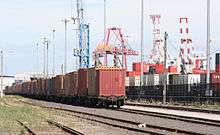Swanson Dock
Swanson Dock is an international shipping facility in Melbourne, Victoria, Australia. It was constructed between 1966 and 1972 by the Melbourne Harbour Trust, on the north bank of the Yarra River to alleviate congestion in the port and provide the first container shipping terminal in Melbourne.[1] It is located about 2 km downstream from the Melbourne CBD and was named after Victor Swanson, Chairman of the Melbourne Harbour Trust between 1960 and 1972.[2]
History
The construction of Spencer Street bridge over the Yarra River in 1929 reduced the capacity of the river wharves, and led to expansion downstream of port facilities initially with Appleton Dock. Swanson Dock was constructed in 1968 on the former Coode Island as Melbourne's first all-container shipping terminal, reflecting the rapid world-wide change at the beginning of the 1960s, from unit cargo where each product was loaded in different forms of packaging, to shipping cargo in uniform sized containers.[3]
Swanson Dock was officially opened on 7 March 1969, by the Governor of Victoria, Sir Rohan Delacombe, during the 6th biennial conference of the International Association of Ports and Harbors, which was hosted by the Melbourne Harbor Trust in Melbourne. The first international ship to dock (at No 1 West Berth) was the Encounter Bay.[4]

Operation
Swanson Dock East has a berth length of 884 metres (2,900 ft) serviced by six container cranes with 40 hectares (99 acres) of container storage and roadways and rail siding. Swanson Dock West has 944 metres (3,097 ft) of wharves with seven container cranes and 34 hectares (84 acres) of space, with the potential to expand as trade grows. Swanson Dock East and West can accommodate the largest container ships trading with Australia.[5] Railway goods sidings serve both Swanson Dock East and West, permitting the transfer of shipping containers between sea and rail transport. Originally provided in the 1960s with the development of the port, they were later removed.[6] Rail facilities were restored between 2002 and 2003 with a new 1500 metre long siding and overpasses to separate road traffic.[7][8]

Swanson Dock was one site of the 1998 Australian waterfront dispute when dockworkers were locked out by Patrick Stevedores, and replaced with non-union labour. The Maritime Union of Australia workers picketing East Swanson dock invited Wendy Lowenstein to record them "making history" which was incorporated into a second edition of her book Under the Hook.
See also
- Port of Melbourne
- History of Melbourne Docklands
References
- Port of Melbourne Authority, Swanson Dock History
- Victor George Swanson, 1910-1962
- Colin Jones, 'Wharves and Docks' eMelbourne encyclopedia
- Port of Melbourne Corporation, Swanson Dock history
- Port of Melbourne Planning Scheme, 21.01-4 Port Facilities
- "Australia: Rail link to Swanson Dock in Melbourne", Australian, Nationwide News Pty Limited, 15 July 2002, ISSN 1038-8761
- "Road & rail development". Port of Melbourne. www.portofmelbourne.com. Archived from the original on 16 March 2004. Retrieved 30 March 2008.
- "Media Release: RAIL ACCESS RETURNED TO SWANSON DOCK WEST AS TRADE RECORD ANNOUNCED". www.dpc.vic.gov.au. Archived from the original on 19 May 2011. Retrieved 30 March 2008.
Further reading
| Wikimedia Commons has media related to Swanson Dock. |
- Kim Dovey: Fluid City: Transforming Melbourne's Urban Waterfront, London: Routledge, 2005